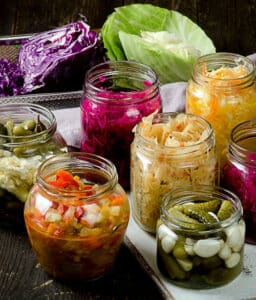How the method of cooking affects the amount of nutrients
The way you cook has a big impact on the preservation of the nutrients it contains. In this article we will look at how different cooking methods affect the amount of nutrients in the finished food.
Heat treatment of products improves digestion and increases the absorption of many nutrients. For instance, the proteins in boiled eggs are 180% more digestible than those in raw eggs.
Respectively, the heat treatment of the products makes the products easier for us to digest and, accordingly, our body spends less energy on food processing, which on the one hand is good. However, during cooking, the amount of nutrients in them changes and both vitamins and minerals are lost:
- Water-soluble vitamins - vitamin C and B vitamins (thiamine (B1), riboflavin (B2), niacin (B3), pantothenic acid (B5), pyridoxine (B6), folic acid (B9) and cobalamin (B12));
- Fat-soluble vitamins: vitamins A, D, E and K;
- Minerals - potassium, magnesium, sodium and calcium.
You can find out more about vitamins and their role in our body HERE.
Cooking
There are two types of cooking, which differ depending on the water temperature:
- Simmer - temperature 85 - 93 ° C
- Boiling point - temperature 100 ° C
Vegetables are usually a great source of vitamin C, but cooking vegetables lose a lot of vitamins - they are both destroyed by heat and water-soluble vitamins are washed away (if you cook soup, it doesn't matter, but when you pour potatoes you pour a lot of water into the water as well). soluble vitamins).
Cooking reduces the content of vitamin C more than any other cooking method, because it is both water-soluble and sensitive to heat. Broccoli, spinach and lettuce can lose up to 50% or more of vitamin C when cooked.
B vitamins are also sensitive to heat and, for example, up to 60% of thiamine, niacin and other B vitamins are lost when cooking meat.
On the other hand, it has been shown that cooking fish retains significantly more omega-3 fatty acids than baking or cooking in the microwave.
If you want to keep the nutrients in fresh products to a maximum during cooking - make stews or soups (if you do not drain, you will also keep 100% of minerals and 70 - 90% of B vitamins).
Grilling and baking
Grilling is one of the most popular cooking methods, as it gives the food a great taste.
However, up to 40% of B vitamins and minerals (heat and nutrient-rich juices run off the charcoal) may be lost during grilling or frying - polycyclic aromatic hydrocarbons (PAHs - polycyclic aromatic hydrocarbons), which are potentially carcinogenic (formed by a fat pilot on a hot surface and smoked into the product to be grilled).
On the other hand, when frying - whether in fat or oil - the food absorbs a large amount of oil, as a result of which additional calories and "unhealthy" fats are added to the food. When frying products should not be "floated in fat" - use a minimal amount of oil, preferably not by pouring it into the pan, but spraying with a dispenser.
You can read more about the use of different oils and the nutrients they contain HERE.
Cooking in the microwave
The microwave oven is a simple, convenient and safe method of cooking.
The loss of nutrients is affected by both the type of cooking and the cooking time (how long the product is heated). Cooking in the microwave is one of the best ways to preserve the maximum amount of nutrients, because the cooking time is short and the effect of heat on the products is reduced.
Several studies have found that a microwave oven is the best method of cooking, for example, to preserve the antioxidant activity of garlic and mushrooms.
However, even when cooking in a microwave oven, nutrients are lost, for example - when cooking green vegetables, about 20 - 30% of vitamin C is lost.
Baking and roasting
The main difference from other types of preparation - there are no liquids that can flush out vitamins and minerals like water or add extra calories like fats and oils.
With this cooking method, the loss of vitamins, including vitamin C, is minimal.
However, the cooking time in the oven is long and cooking takes place at high temperatures - so the B vitamin content can be reduced by as much as 40% (for example, when roasting meat in the oven).
Stewing
When stewing, the food is prepared in a saucepan over medium or high heat in a small amount of water, oil or butter. The food is often mixed - so the temperature is higher and the cooking time is relatively shorter.
In general, stewing is a healthy way of cooking, as the preservation of liquid (water) prevents the loss of B and other water-soluble vitamins, and the addition of fat improves the absorption of fat-soluble vitamins and antioxidants in vegetables. For instance, in this study it was found that lycopene blood levels increased by 80% more when people ate tomatoes stewed in olive oil.
On the other hand, baking has been shown to stir considerably reduces the amount of vitamin C in vegetables.
Frying
Deep frying is a popular cooking method because the products become crispy on the outside and soft on the inside. But cooking takes place in a large amount of fat or oil and at a relatively high temperature - so all the nutrients that are sensitive to high temperatures are "damaged".
For example - Fatty fish is one of the best sources of omega-3 fatty acids, but they disappear when frying these fish (for instance, frying tuna reduces its omega-3 content to 70-85%, but loss of baking omega-3 is minimal).
Prolonged heating of the oil to high temperatures produces toxic substances called aldehydes. Aldehydes are associated with an increased risk of cancer and other diseases. The amount of aldehyde is affected by the type of oil, the temperature and the cooking time. Reusing the oil (heating) also increases the formation of aldehydes.
On the other hand frying preserves vitamins C and B better.
Respectively - if you like fried foods and you are not worried about the increased amount of calories (for example - fried potatoes contain about 161 calories and less than 1 g of fat, but one medium serving of french fries can contain up to 453 calories and 23 g of fat) - use fats suitable for frying, try not to reuse them and look for other sources of omega-3 if you are also frying fish.
Steaming
Steaming is one of the best cooking methods if you want to preserve as many nutrients as possible - including water-soluble vitamins, for example - steaming broccoli, spinach and lettuce reduces their vitamin C content by only 9 - 15%.
How to maximize the nutrients in the products during cooking?
- Use as little water as possible when cooking;
- Do not pour the liquid left in the pan after frying the vegetables or meat - use it, for example, to make the sauce;
- Do not peel the vegetables before cooking. Better yet, don't peel it at all to increase the density of fiber and nutrients.
- Try to eat cooked and steamed vegetables in one or two days, as the content of vitamin C may continue to decrease under the influence of light.
- If possible, cut the products after cooking, not before. When cooked whole, they are less exposed to heat and water.
- Try to minimize the cooking time of the products to minimize the effects of heat on them.
Key takeaways
Remember that there are no ideal cooking methods that preserve all the nutrients - so choose the one that suits you - depending on whether you want to maximize the nutritional value of the meal, or - you just like it - but then you should pay more attention to the choice of products. because a balanced diet is the basis of both your health and beauty.
And - do not let the nutrients in the food drain into the sewer - cook in a small amount of water and use the resulting liquids, for example, to make delicious sauces.
Loss of key nutrients for different products depending on the type of preparation
Share this article
Follow me on Facebook
I recommend reading these articles as well


The best slimming program
Which is better - fast or gradual weight loss? How to maintain your reduced weight? What is the best weight loss program?

What are Probiotics?
How do probiotics affect our health and performance? Can they help you lose weight and belly fat?

Cold and flu remedies
How is the common cold different from the flu? How to relieve cold and flu symptoms? Which cold and flu remedies work and which don't?

